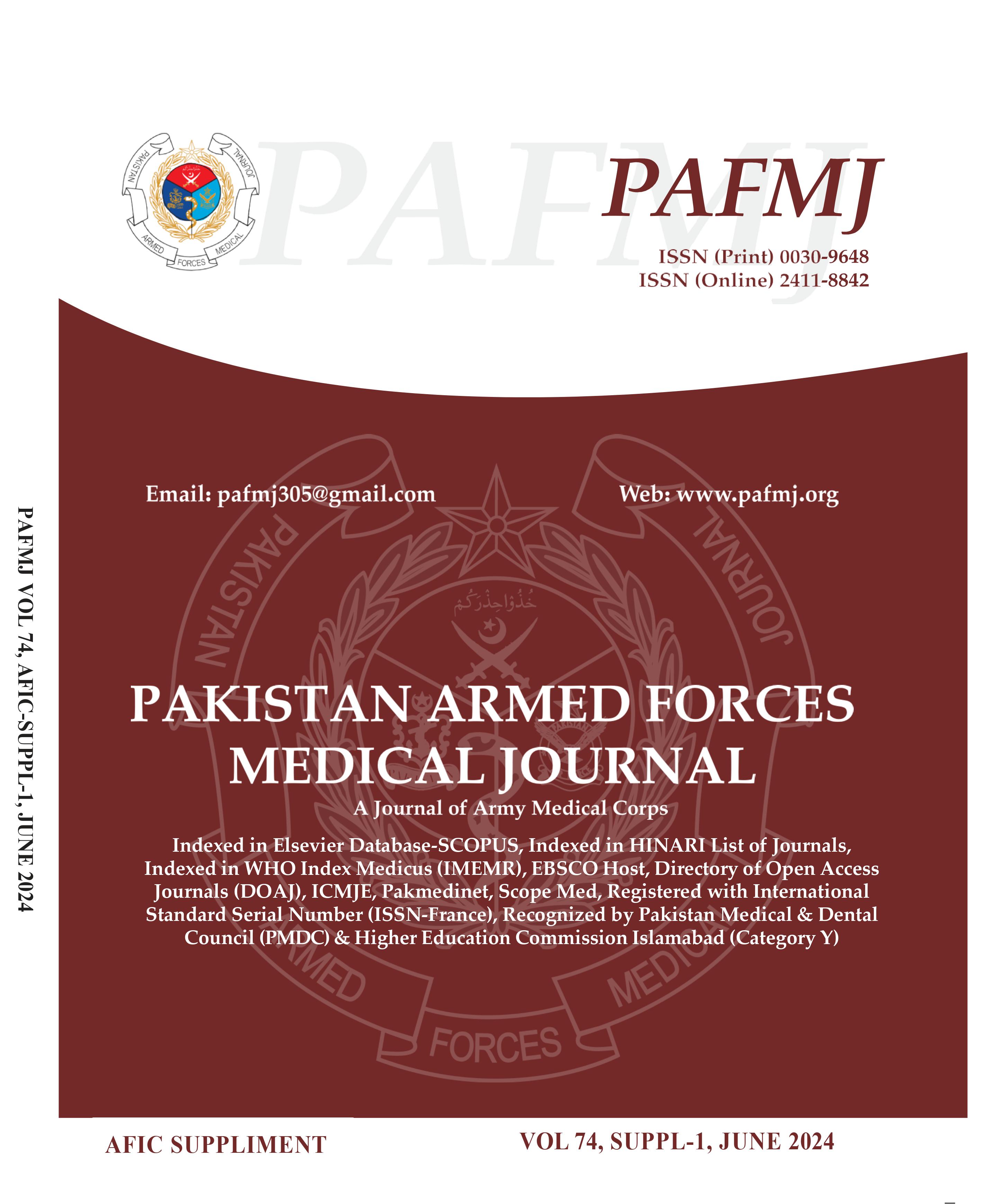Association of Severity of Coronary Artery Disease With SYNTAX Score and Ankle Brachial Index
DOI:
https://doi.org/10.51253/pafmj.v74iSUPPL-1.10579Keywords:
Ankle Brachial Index, Coronary angiography, Coronary Artery Disease, SYNTAX ScoreAbstract
Objective: To compare the Ankle Brachial Index and SYNTAX score in predicting Coronary Artery Disease severity and the variation of ABI with respect to SYNTAX score.
Study Design: Analytical Cross-sectional study.
Place and Duration of Study: Armed Forces Institute of Cardiology/National Institute of Heart Diseases, Rawalpindi; from Jan-Jun 2023.
Methodology: Total 216 coronary angiographically confirmed cases of Coronary Artery Disease were consecutively enrolled in study and data was gathered prospectively on a pre-designed proforma containing patients’ demographic details, risk factors and study’s focal variables such as; Ankle Brachial Index, SYNTAX Score, coronary artery disease severity. Association of categorized data was found by Chi-square test and Fischer Exact test. Correlation analysis was done to find the relationship between Ankle Brachial Index and SYNTAX score with p<0.05 was taken as statistically significant.
Results: Out of 216 study participants, males were 180(83.3%) and females were 36(16.7%) having mean age 59.97±10.72 years. Majority of the patients had low SYNTAX score, 96(44.4%) and 95(43.9%) patients ranged in 0.91-1.0 ABI. A statistically significant and negative correlation between ABI and SYNTAX score (r=-0.879; p<0.001) and significant association of ABI and SYNTAX score with CAD severity (p<0.001) was found.
Conclusion: Although Ankle Brachial Index is an indicator of Peripheral Arterial Disease but it can also be used as an independent predictor and non-invasive and time saving indicator of complexity of Coronary Artery Disease prior to coronary angiography.
Downloads
References
Mostafa Abdelmonaem MD, Ahmed Reda MD, Amira Nour MD. Correlation Between Ankle Brachial Index and SYNTAX Score to Predict Severity of Coronary Artery Disease. Vasc Dis Manag [Internet]. 2021 Feb 26 [cited 2023 Apr 7]; 18(3).
Saha A, Kuila M, Sharma RK. Relationship of severity of coronary artery disease with fasting blood sugar and glycosylated hemoglobin. Asian J Med Sci. 2022; 13(3): 38–42.
https://doi.org/10.3126/ajms.v13i3.40416
Kimokoti RW, Newby PK. Dietary patterns, smoking, and cardiovascular diseases: a complex association. Curr Nutr Rep. 2013; 2: 113–25. https://doi.org/10.1007/s13668-013-0043-5
Nandi S, Mukherjee A, Khanra D, Biswas K. Association of severity of coronary artery disease by SYNTAX score (SS) and lower extremity arterial disease by duplex ultrasound (DUS) study-an Indian perspective. Egypt Heart JournalEHJ Off Bull Egypt Soc Cardiol. 2020; 72(1): 56–56.
https://doi.org/10.1186/s43044-020-00091-z
Madjid M, Fatemi O. Components of the Complete Blood Count as Risk Predictors for Coronary Heart Disease. Tex Heart Inst J. 2013; 40(1): 17–29.
Kiani SS, Ashraf W, Khan MN, Chaudhry AA, Azad N, Rehman WU, et al. The Role of High-sensitive C-Reactive Protein in predicting Severity of Coronary Artery Disease in Patients with Acute Coronary Syndromes. Pak Heart J. 2023 Apr 1; 56(1): 33–6. https://doi.org/10.47144/phj.v56i1.2468
Inouye M, Abraham G, Nelson CP, Wood AM, Sweeting MJ, Dudbridge F, et al. Genomic risk prediction of coronary artery disease in 480,000 adults: implications for primary prevention. J Am Coll Cardiol. 2018; 72(16): 1883–93
https://doi.org/10.1016/j.jacc.2018.07.079
Wu TT, Gao Y, Zheng YY, Ma YT, Xie X. Atherogenic index of plasma (AIP): a novel predictive indicator for the coronary artery disease in postmenopausal women. Lipids Health Dis. 2018; 17(1): 1–7. https://doi.org/10.1515/med-2022-0590
Liu L, Sun H, Nie F, Hu X. Prognostic Value of Abnormal Ankle–Brachial Index in Patients with Coronary Artery Disease: A Meta-Analysis. Angiology. 2020 Jul 1;71(6):491–7.
https://doi.org/10.1177/0003319720911582
Witberg G, Zusman O, Codner P, Assali A, Kornowski R. Impact of coronary artery revascularization completeness on outcomes of patients with coronary artery disease undergoing transcatheter aortic valve replacement: a meta-analysis of studies using the residual SYNTAX score (Synergy Between PCI with Taxus and Cardiac Surgery). Circ Cardiovasc Interv. 2018; 11(3): e006000.
https://doi.org/10.1161/117.006000.
Sheikh MSA. Prevalence of coronary artery disease and its associated risk factors in Aljouf region of Saudi Arabia. Bangladesh J Med Sci. 2022 Jan 1; 21(1): 201–5.
https://doi.org/10.3329/bjms.v21i1.56350
SYNTAX Score Calculator [Internet]. [cited 2023 Apr 7]. Available from: http://syntaxscore.org/calculator/syntaxscore/frameset.htm
Sartore G, Caprino R, Ragazzi E, Bianchi L, Lapolla A, Piarulli F, et al. The ankle-brachial index for assessing the prevalence of peripheral artery disease and cardiovascular risk in patients with type 2 diabetes mellitus. Nutr Metab Cardiovasc Dis. 2023 Mar 1; 33(3): 560–7. https://doi.org/10.1016/j.numecd.2022.11.019
Resnick HE, Lindsay RS, McDermott MM, Devereux RB, Jones KL, Fabsitz RR, et al. Relationship of High and Low Ankle Brachial Index and Cardiovascular Disease Mortality. Circulation. 2004 Feb 17; 109(6): 733–9.
https://doi.org/10.1161/01.CIR.0000112642.63927.54
Lin MC, Tseng VS, Lin CS, Chiu SW, Pan LK, Pan LF, et al. Quantitative Prediction of SYNTAX Score for Cardiovascular Artery Disease Patients via the Inverse Problem Algorithm Technique as Artificial Intelligence Assessment in Diagnostics. Diagnostics. 2022 Dec; 12(12): 3180.
https://doi.org/10.3390/diagnostics12123180
Ikeda N, Kogame N, Iijima R, Nakamura M, Sugi K. Impact of carotid artery ultrasound and ankle-brachial index on prediction of severity of SYNTAX score. Circ J Off J Jpn Circ Soc. 2013; 77(3): 712–6. https://doi.org/10.1161/ATVBAHA.120.315747
Korkmaz L, Adar A, Erkan H, Ağaç MT, Acar Z, Kurt IH, et al. Ankle-brachial index and coronary artery lesion complexity in patients with acute coronary syndromes. Angiology. 2012 Oct; 63(7): 495–9. https://doi.org/10.1177/0003319711429561
Thurston B, Dawson J. Ankle Brachial Pressure Index: An update for the vascular specialist and general practitioner. Vascular. 2019; 27(5): 560–70. https://doi.org/10.1177/1708538119842
Amer MS, Tawfik HM, Elmoteleb AMA, Maamoun MMA. Correlation between ankle brachial index and coronary artery disease severity in elderly Egyptians. Angiology. 2014 Nov; 65(10): 891–5. https://doi.org/10.1177/0003319713510594
Chang ST, Chen CL, Chu CM, Chung CM, Hsu JT, Cheng HW, et al. Ankle-arm index as a predictor of lesion morphology and risk classification for coronary artery disease undergoing angioplasty. Int J Cardiol. 2006 Nov 18; 113(3): 385–90.
https://doi.org/10.1016/j.ijcard.2005.11.102
The Relationship between SYNTAX Score and Resting/Post-exercise Ankle-Brachial index in Patients with Acute Coronary Syndrome | International Journal of Current Medical and Biological Sciences. 2021 Aug 23.















